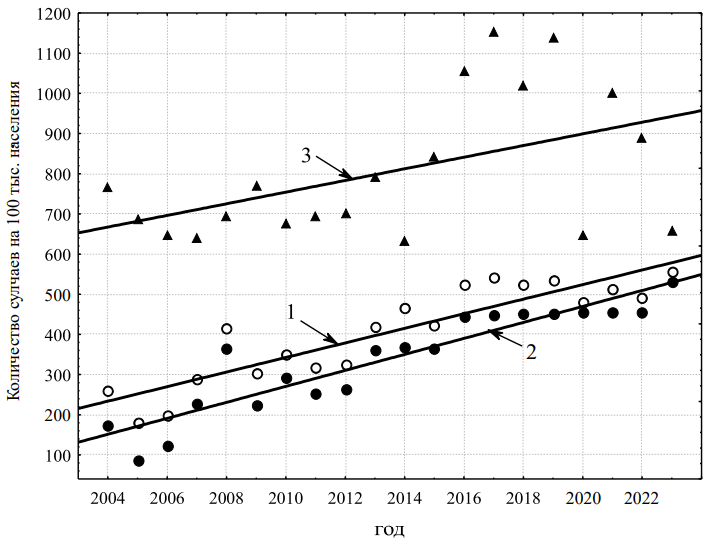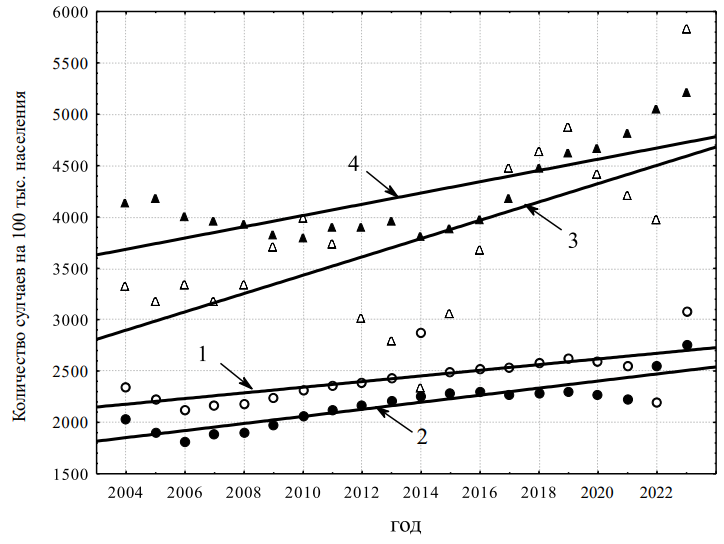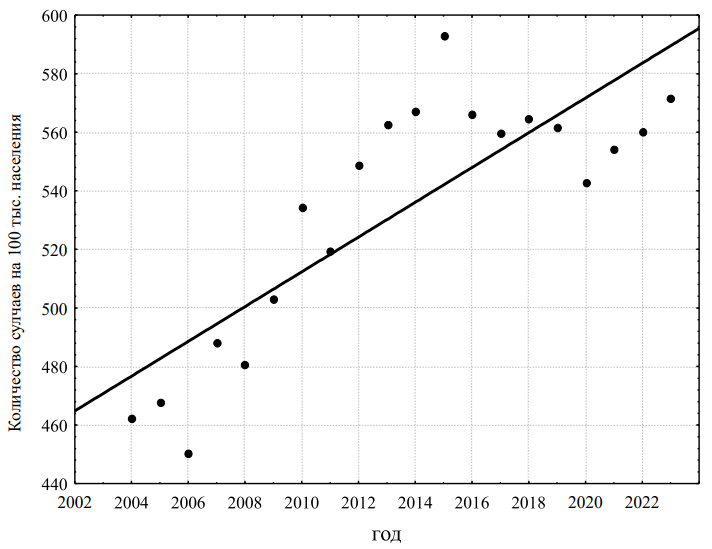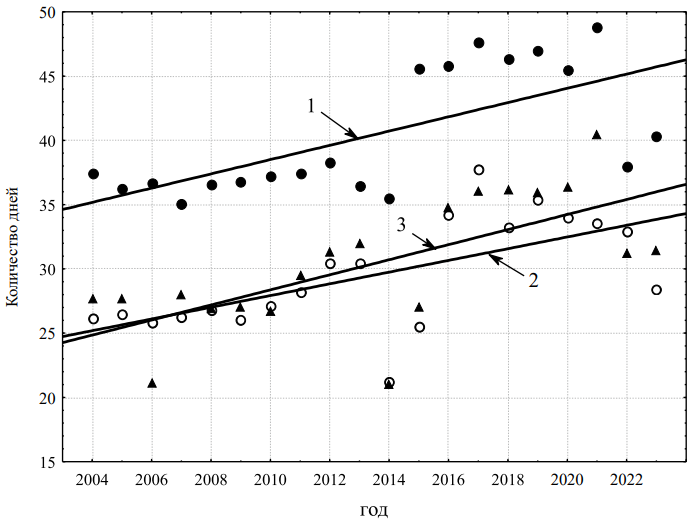Scroll to:
Comparative analysis of the incidence of mental and behavioral disorders over a long period of time in the Luhansk region
https://doi.org/10.21886/2219-8075-2025-16-1-14-21
Abstract
Objective: performing a comparative analysis of various indicators of mental and behavioral disorders in the population living in the Lugansk region over a long period of time, followed by the development of scientifically based recommendations. Materials and methods: the research was carried out in the Luhansk region for the period 2004–2023. The total time interval of 20 years is divided into two equal ten-year periods: peacetime (2004–2013) and wartime (2014–2023). The work used official data from the annual reports of the statistical department of the Luhansk Clinical Neuropsychiatric Hospital of the LPR and data from the Lugansk Coordination Center for Health Protection “Indicators of public health and activities of medical organizations of the Luhansk region”, “Indicators of public health and activities of medical organizations of the Luhansk People’s Republic” for 2004–2023. Results: when comparing the peacetime and wartime periods, a statistically significant deterioration in all indicators characterizing mental health during wartime was proved. Conclusions: the depressive wartime environment in the Luhansk People’s Republic is a significant risk factor for the occurrence or exacerbation of mental disorders, an increase in the duration of inpatient treatment of patients with mental and behavioral disorders, a deterioration in the clinical prognosis of the disease and, as a result, disability
For citations:
Bobyk O.A., Kulakovа S.I., Kapranov S.V., Tarabtsev D.V. Comparative analysis of the incidence of mental and behavioral disorders over a long period of time in the Luhansk region. Medical Herald of the South of Russia. 2025;16(1):14-21. (In Russ.) https://doi.org/10.21886/2219-8075-2025-16-1-14-21
Introduction
The health of the population is a vital indicator of the social, spiritual, and economic well-being of any state, and serves as a criterion for its sustainable development [1][2]. Mental health is an essential and inseparable component of overall health, underpinning our capacity to make decisions, build relationships, and shape the world we live in [3][4]. Mental and behavioral disorders are currently classified among the diseases of modern civilization. A depressive living environment is a key factor contributing to the development of mental disorders.
A depressive social environment emerges during periods of sharp economic decline and acquires distinct features of social depression, such as a deterioration in the standard (economic factors), quality (social factors), style (socio-psychological factors), and structure (socio-economic factors) of life [5]. Since 2014, residents of the Luhansk People’s Republic have been living under conditions of a depressive environment characterized by extreme wartime stress. This type of stress response overwhelms the adaptive capacities of the human psyche due to the total disruption of normal life, the constant presence of death as a theme, and the sense of an impending and inescapable catastrophe. As a result, high levels of chronic anxiety and fear are formed [6].
In light of the above, it is highly relevant to undertake a scientific study focused on the analysis of morbidity rates for mental disorders in the Luhansk region over an extended period.
The study aims to conduct a comparative analysis of various indicators of mental and behavioral disorders among the Luhansk region population over a long-term period, and to develop scientifically grounded recommendations.
Materials and Methods
The study was conducted in the Luhansk region in 2004–2023, encompassing three distinct historical phases: the first phase (2004-2013), during which Luhansk Oblast was part of Ukraine; the second phase (2014-2021) corresponding to the establishment and functioning of the Luhansk People’s Republic (LPR) as a separate entity; and the third phase (2022–2023), when the LPR operated as part of the Russian Federation.
The overall 20-year interval was divided into two equal decades: a peaceful period (2004–2013) and a wartime period (2014–2023).
This study used official data from the annual reports of the Statistical Department of the State Budgetary Healthcare Institution “Luhansk Clinical Psychoneurological Hospital” of the LPR, as well as data from the Luhansk Coordinating Health Protection Center, including “Population Health Indicators and Medical Organizations’ Activities in Luhansk Oblast” and “Population Health Indicators and Medical Organizations’ Activities in the Luhansk People’s Republic”. These sources provide annual data for 2004–2023 on the mental health status of populations in the settlements of the former Luhansk Oblast that became part of the LPR in 2014 (including the cities of Luhansk, Alchevsk, Antratsyt, Bryanka, Kirovsk, Krasnodon, Krasnyi Luch, Pervomaisk, Rovenky, Sverdlovsk, Stakhanov, as well as Lutuhyne, Perevalsk, and Slavyanoserbsk districts).
The following mental health indicators were analyzed:
- Detection and registration rates (per 100,000 population) of mental and behavioral disorders among the total population, adults, adolescents, and children;
- Detection and registration rates (per 100,000 population) of mental and behavioral disorders in the total population according to the following ICD-10 nosological groups: F00-F09 (organic, including symptomatic, mental disorders), F20-F29 (schizophrenia, schizotypal, and delusional disorders), F30-F39 (mood [affective] disorders), F40-F69 (neurotic, stress-related and somatoform disorders; personality and behavioral disorders in adulthood), F80-F99 (psychological [mental] development disorders), and F70-F79 (intellectual disabilities)
- Disability and initial disability incidence among patients diagnosed with mental and behavioral disorders (per 100,000 population);
- Duration of inpatient treatment for patients with mental and behavioral disorders across the nosological categories F00-F09, F20-F29, F30-F39, F40-F69, F80-F99, and F70-F79.
“Detection” refers to incidence, i.e., all newly identified cases of mental and behavioral disorders (ICD-10 Class V F) during the current year, standardized per 100,000 population. “Registration” refers to prevalence, encompassing newly identified cases during the current year plus patients with previously established diagnoses who remain under medical supervision, also expressed per 100,000 population.
A comparative analysis of the above mental health indicators between the peaceful and wartime periods was conducted.
Statistical processing and interpretation of the data employed the Mann-Whitney U-test for independent samples; differences were considered statistically significant at p < 0.05. This nonparametric test was selected as an alternative to the t-test when normal distribution assumptions were not met.
To determine trends in various mental health indicators over time, regression equations were constructed to characterize yearly changes, assess the statistical significance of increases or decreases, and forecast future values through extrapolation, accompanied by graphical presentations.
Statistical analyses were performed using Statistica 6.0 software.
Results
At the first stage, indicators reflecting the mental health of the population in the city of Luhansk were compared. The results showed that, compared to 2004–2013, the following mental health indicators increased in the city in 2014–2023:
- Incidence of mental and behavioral disorders among the total and adult populations;
- Prevalence of mental and behavioral disorders among the total, adult, adolescent, and child populations;
- Disability rates and new disability registrations among patients diagnosed with mental and behavioral disorders.
These data are presented in Table 1.
Таблица / Table 1
Показатели, характеризующие психическое здоровье населения в г. Луганске за сравниваемые периоды 2004–2013 гг. и 2014–2023 гг. (на 100 тыс. населения)
Indicators characterizing the mental health of the population in Lugansk for the compared periods of 2004–2013. and 2014–2023 (per 100 thousand population)
|
Показатели психического здоровья Mental health indicators |
Периоды Periods |
p |
|
|
2004–2013 M±SЕ |
2014–2023 M±SЕ |
||
|
Выявляемость расстройств психики и поведения всего населения Incidence of mental and behavioral disorders in the entire population |
306,45±25,15 |
505,95±12,93 |
0,000157 |
|
Выявляемость расстройств психики и поведения взрослого населения Incidence of mental and behavioral disorders among the adult population |
237,33±29,16 |
443,54±14,87 |
0,000212 |
|
Выявляемость расстройств психики и поведения подростков Incidence of mental and behavioral disorders among adolescents |
703,43±46,37 |
664,7±97,98 |
> 0,05 |
|
Выявляемость расстройств психики и поведения детей Incidence of mental and behavioral disorders among children |
706,51±16,62 |
903,53±63,74 |
> 0,05 |
|
Учтённость расстройств психики и поведения всего населения Prevalence of mental and behavioral disorders among the entire population |
2274,72±33,81 |
2602,84±74,12 |
0,001152 |
|
Учтённость расстройств психики и поведения взрослого населения Prevalence of mental and behavioral disorders among the adult population |
2008,13±42,52 |
2349,41±53,44 |
0,000157 |
|
Учтённость расстройств психики и поведения подростков Prevalence of mental and behavioral disorders among adolescents |
3350,41±113,70 |
4140,22±307,87 |
0,034294 |
|
Учтённость расстройств психики и поведения детей Prevalence of mental and behavioral disorders among children |
3950,77±38,78 |
4461,77±155,26 |
0,023343 |
|
Инвалидность с диагнозом расстройств психики и поведения Disability with a diagnosis of mental and behavioral disorders |
501,98±12,15 |
564,24±4,08 |
0,000881 |
|
Первичный выход на инвалидность с диагнозом расстройств психики и поведения Initial access to disability with a diagnosis of mental and behavioral disorders |
25,58±1,13 |
17,70±1,02 |
0,000670 |
An evaluation of mental health indicators across the Luhansk region (calculated for the administrative territories incorporated into the LPR) revealed that in 2014–2023, compared to 2004-2013, the following indicators increased:
- Incidence of mental and behavioral disorders among the total, adult, and adolescent populations;
- Prevalence of mental and behavioral disorders among the total and child populations;
- Incidence of mental and behavioral disorders among the total population with diagnoses F00-F09 and F30-F39;
- Prevalence of mental and behavioral disorders among the total population with diagnoses F00-F09, F40-F69, F80-F99, and F70-F79;
- Disability rates and new disability registrations among patients diagnosed with mental and behavioral disorders.
These data are presented in Table 2.
Таблица / Table 2
Показатели, характеризующие психическое здоровье населения Луганского региона за сравниваемые периоды 2004–2013 гг. и 2014–2023 гг. (на 100 тыс. населения)
Indicators characterizing the mental health of the population of the Lugansk region for the compared periods of 2004-2013. and 2014-2023 (per 100 thousand population)
|
Показатели психического здоровья Mental health indicators |
Периоды Periods |
p |
|
|
2004–2013 M±SЕ |
2014–2023 M±SЕ |
||
|
Выявляемость расстройств психики и поведения всего населения Incidence of mental and behavioral disorders in the entire population |
267,90±3,24 |
328,82±9,84 |
0,000507 |
|
Выявляемость расстройств психики и поведения взрослого населения Incidence of mental and behavioral disorders among the adult population |
248,42±4,72 |
283,35±8,95 |
0,015565 |
|
Выявляемость расстройств психики и поведения подростков Incidence of mental and behavioral disorders among adolescents |
511,44±10,71 |
454,71±39,96 |
0,049367 |
|
Выявляемость расстройств психики и поведения детей Incidence of mental and behavioral disorders among children |
555,85±15,78 |
608,77±39,05 |
> 0,05 |
|
Учтённость расстройств психики и поведения всего населения Prevalence of mental and behavioral disorders among the entire population |
2559,99±38,91 |
2893,22±65,80 |
0,000881 |
|
Учтённость расстройств психики и поведения взрослого населения Prevalence of mental and behavioral disorders among the adult population |
2762,26±25,65 |
2763,22±29,57 |
> 0,05 |
|
Учтённость расстройств психики и поведения подростков Prevalence of mental and behavioral disorders among adolescents |
4071,29±48,28 |
4338,05±126,92 |
> 0,05 |
|
Учтённость расстройств психики и поведения детей Prevalence of mental and behavioral disorders among children |
2996,22±41,07 |
3276,77±75,11 |
0,010166 |
|
Выявляемость патологии с диагнозом F00–09 Incidence of pathology with diagnosis F00–09 |
99,09±3,64 |
142,41±6,06 |
0,000212 |
|
Выявляемость патологии с диагнозом F20–29 Incidence of pathology with diagnosis F20–29 |
21,40±0,42 |
21,86±0,70 |
> 0,05 |
|
Выявляемость патологии с диагнозом F30–39 Incidence of pathology with diagnosis F30–39 |
22,83±0,42 |
18,79±0,88 |
0,006482 |
|
Выявляемость патологии с диагнозом F 40–69, F 80–99 Incidence of pathology with diagnosis F40–69, F 80–99 |
127,83±3,27 |
132,46±4,11 |
> 0,05 |
|
Выявляемость патологии с диагнозом F 70–79 Incidence of pathology with diagnosis F70–79 |
24,25±1,22 |
20,56±1,27 |
> 0,05 |
|
Учтённость патологии с диагнозом F00–09 Prevalence of pathology with diagnosis F00–09 |
746,12±18,47 |
876,19±20,29 |
0,000670 |
|
Учтенность патологии с диагнозом F20–29 Prevalence of pathology with diagnosis F20–29 |
446,07±3,99 |
438,18±8,16 |
> 0,05 |
|
Учтенность патологии с диагнозом F30–39 Prevalence of pathology with diagnosis F30–39 |
171,05±3,16 |
167,07±4,30 |
> 0,05 |
|
Учтенность патологии с диагнозом F40–69, F 80–99 Prevalence of pathology with diagnosis F40–69, F 80–99 |
919,27±14,05 |
792,21±23,70 |
0,000379 |
|
Учтенность патологии с диагнозом F 70–79 Prevalence of pathology with diagnosis F70–79 |
555,55±2,22 |
506,54±10,82 |
0,000156 |
|
Инвалидность с диагнозом расстройств психики и поведения Disability with a diagnosis of mental and behavioral disorders |
552,27±14,82 |
615,80±13,68 |
0,003186 |
|
Первичный выход на инвалидность с диагнозом расстройств психики и поведения Initial access to disability with a diagnosis of mental and behavioral disorders |
23,66±0,80 |
16,04±0,72 |
0,000211 |
Regarding the duration of inpatient treatment for patients with mental and behavioral disorders, it was established that in Luhansk in 2014–2023, compared to 2004–2013, treatment durations increased for patients with diagnoses F00-F09, F20-F29, F40-F69, F80-F99, and F70-F79. For the entire Luhansk region, treatment durations increased for patients with diagnoses F00-F09, F20-F29, F30-F39, F40-F69, F80-F99, and F70-F79.
These data are presented in Table 3.
Таблица / Table 3
Сроки стационарного лечения пациентов с расстройствами психики и поведения (дни) в г. Луганске и Луганском регионе за сравниваемые периоды 2004–2013 гг. и 2014–2023 гг.
Duration of inpatient treatment for patients with mental and behavioral disorders (days) in Lugansk and the Lugansk region for the compared periods 2004–2013. and 2014–2023
|
Показатели психического здоровья Mental health indicators |
Периоды Periods |
p |
|
|
2004–2013 M±SЕ |
2014–2023 M±SЕ |
||
|
Город Луганск (Луганская республиканская клиническая психоневрологическая больница) City of Lugansk (Lugansk Republican Clinical Psychoneurological Hospital) |
|||
|
Сроки лечения патологии с диагнозом F00–09 Terms of treatment for pathology with a diagnosis of F00–09 |
36,83±0,27 |
44,06±1,42 |
0,002497 |
|
Сроки лечения патологии с диагнозом F20–29 Terms of treatment for pathology with a diagnosis of F20–29 |
58,39±0,48 |
62,10±2,43 |
0,004072 |
|
Сроки лечения патологии с диагнозом F30–39 Terms of treatment for pathology with a diagnosis of F30–39 |
42,28±0,80 |
41,37±2,46 |
> 0,05 |
|
Сроки лечения патологии с диагнозом F 40–69, F 80–99 Terms of treatment for pathology with a diagnosis of F40–69, F 80–99 |
27,41±0,55 |
31,63±1,60 |
0,034294 |
|
Сроки лечения патологии с диагнозом F 70–79 Terms of treatment for pathology with a diagnosis of F70–79 |
27,79±0,95 |
33,05±1,78 |
0,021135 |
|
Всего по Луганскому региону Total for Lugansk region |
|||
|
Сроки лечения патологии с диагнозом F00–09 Terms of treatment for pathology with a diagnosis of F00–09 |
46,48±0,79 |
52,37±1,32 |
0,008151 |
|
Сроки лечения патологии с диагнозом F20–29 Terms of treatment for pathology with a diagnosis of F20–29 |
63,87±1,32 |
70,26±2,60 |
0,045155 |
|
Сроки лечения патологии с диагнозом F30–39 Terms of treatment for pathology with a diagnosis of F30–39 |
37,49±0,63 |
42,56±2,08 |
0,019111 |
|
Сроки лечения патологии с диагнозом F 40–69, F 80–99 Terms of treatment for pathology with a diagnosis of F40–69, F 80–99 |
22,86±0,27 |
30,55±1,86 |
0,010166 |
|
Сроки лечения патологии с диагнозом F 70–79 Terms of treatment for pathology with a diagnosis of F70–79 |
43,10±1,50 |
48,86±1,97 |
0,028366 |
Using extrapolation methods, a statistically significant increasing trend was identified over the entire study period (2004–2023) in Luhansk for:
- Incidence of mental and behavioral disorders among the total population (correlation coefficient r = 0.90, p << 0.05), adult population (r = 0.92, p << 0.05), and children (r = 0.49, p = 0.03) (see Fig. 1);
- Prevalence of mental and behavioral disorders among the total population (r = 0.67, p = 0.001), adult population (r = 0.89, p << 0.05), adolescents (r = 0.64, p = 0.002), and children (r = 0.74, p = 0.002) (see Fig. 2);
- Disability rates among patients diagnosed with mental and behavioral disorders (r = 0.83, p << 0.05) (see Fig. 3);
- Average duration of inpatient treatment for patients with diagnoses F00-F09 (r = 0.68, p = 0.001), F40-F69 and F80-F99 (r = 0.63, p = 0.003), and F70-F79 (r = 0.67, p = 0.001) (see Fig. 4).

Рисунок 1. Тренды изменения выявляемости расстройств психики и поведения по г. Луганску: 1 — всего населения ( ), 2 — взрослого населения (●), 3 — детей (▲ ).
Figure 1. Trends in changes in the incidence of mental and behavioral disorders in the city of Lugansk: 1 — total population ( ), 2 — adult population (●), 3 — children (▲).

Рисунок 2. Тренды изменения учтенности расстройств психики и поведения по г. Луганску: 1 — всего населения ( ), 2 — взрослого населения (●), 3 — подростков ( ), 4 — детей (▲ ).
Figure 2. Trends in changes in the prevalence of mental and behavioral disorders in the city of Lugansk: 1 — total population ( ), 2 — adult population (●),3 — teenagers ( ), 4 — children (▲).

Рисунок 3. Тренд изменения инвалидности с диагнозом расстройств психики и поведения (●) по г. Луганску.
Figure 3. Trend in changes in disability with a diagnosis of mental and behavioral disorders (●) in Lugansk.

Рисунок 4. Тренды изменения средних сроков стационарного лечения пациентов по г. Луганску с расстройствами психики и поведения с диагнозами: 1 — F00–09 ( ), 2 — F 40–69, F 80–99 (●), 3 — F 70–79 (▲ ).
Figure 4. Trends in changes in the average duration of inpatient treatment of patients in Lugansk with mental and behavioral disorders with diagnoses: 1 — F0009 ( ), 2 — F 40–69, F 80–99 (●), 3 — F 70–79 (▲)
Discussion
The data indicate that during the wartime period (2014–2023), compared to the peaceful period (2004–2013), key indicators of mental and behavioral disorders increased in the Luhansk region (including territories incorporated into the LPR), as well as in the city of Luhansk. These increases include incidence and prevalence rates of disorders among the total population (including specific nosological groups), adults, adolescents, and children, as well as the duration of inpatient treatment for patients with mental and behavioral disorders. Additionally, disability rates rose over the compared periods, reflecting an increase in the severity of these conditions. Statistical analysis suggests that the wartime emergency situation has a direct or indirect negative impact on the mental health of various age groups within the population of the Luhansk People’s Republic.
However, the statistical evidence does not show a uniform deterioration of mental health indicators across all territories of the Luhansk region. For example, while these indicators significantly worsened over the 20-year period across the region as a whole (including Luhansk city, Slavyanoserbsk, and Perevalsk districts), the cities of Kirovsk, Sverdlovsk, Krasnyi Luch, and Alchevsk demonstrated stabilization of these indicators. Conversely, Antratsyt, Bryanka, Krasnodon, Pervomaisk, Rovenky, and Stakhanov experienced improvements. This pattern may be explained by the uneven availability of medical staff, especially psychiatrists, in certain cities and district centers, as well as the centralization of psychiatric services in the regional capital, Luhansk. Therefore, the decision was made to base the analysis of mental health in the Luhansk region primarily on data from Luhansk city, supplemented by aggregated information for the region as a whole.
Conclusions
The data indicate a rising trend in the morbidity of mental and behavioral disorders among the total population (adults, adolescents, and children) throughout the entire study period (2004–2023). However, a statistically significant worsening of all mental health indicators was confirmed when comparing the wartime period to the peaceful period. Based on this long-term study in the Luhansk region, we conclude that the depressive environment created by wartime conditions in the Luhansk People’s Republic represents a significant risk factor for the onset or exacerbation of mental disorders. It also contributes to prolonged inpatient treatment durations, worsened clinical prognoses, and increased rates of disability. Therefore, the most pressing current challenge is to enhance the stress resilience of residents of the Luhansk People’s Republic against the persistent psychological trauma induced by ongoing wartime stressors. In this context, timely preventive measures for mental and behavioral disorders become critically important. Psychological support should be provided not only to mentally healthy individuals but also to patients with existing mental disorders through continuous application of psychotherapeutic and rehabilitative interventions alongside mandatory pharmacotherapy. These interventions include various forms of art therapy (visual arts, cinema, and music therapy), relaxation techniques, stress-coping strategies, cognitive-behavioral therapy, and others.
References
1. Shevchenko O. M., Shtofer L. L. Public health as a resource for the stable development of Russian society: risks and threats. Caucasian Science Bridge. 2022;5(2):30-40. (In Russ.) https://doi.org/10.18522/2658-5820.2022.2.2
2. Shastin A.S., Tsepilova T.M., Gazimova V.G., Malykh O.L., Gagarina M.S. Morbidity with temporary incapacity for work in the Southern Federal District of Russia. Selected indicators. Medical Herald of the South of Russia. 2021;12(4):91-100. (In Russ.) https://doi.org/10.21886/2219-8075-2021-12-4-91-100
3. Reshetnikov M. M. Mental health of the population — modern trends and old problems. Nacionalnyj psihologicheskij zhurnal. 2015;1(17):9-15. (In Russ.) https://doi.org/10.11621/npj.2015.0102
4. Voroncova V. V. Fundamentals of mental health and psychosomatic physical training. Molodoj uchenyj. 2023;51(498):432- 434. (In Russ.) eLIBRARY ID: 57879972 EDN: KPCBWE
5. Neshataev A. V. The genesis of scientific ideas about depressed territories in sociological approaches. Materialy Vserossijskoj nauchno-prakticheskoj konferencii (Ekaterinburg, 17–18 marta 2023 g.). Ekaterinburg: Izdatelstvo Uralskogo universiteta, 2023: 351-355. (In Russ.) eLIBRARY ID: 54766089 EDN: BRFETO
6. Evtushenko E. I. Features of the occurrence and prevalence of mental disorders among the population of a military region. Vestnik gigieny i epidemiologii. 2021;25(2):185-187. (In Russ.) eLIBRARY ID: 47290590 EDN: SMBGSC
About the Authors
O. A. BobykLNR
Olga A. Bobyk, assistant of the Department of Psychiatry and Narcology
Lugansk
Competing Interests:
Authors declare no conflict of interest
S. I. Kulakovа
LNR
Svetlana I. Kulakovа, Cand. Sci. (Tech.), Associate professor of Department of Higher Mathematics and Natural Sciences
Alchevsk
Competing Interests:
Authors declare no conflict of interest
S. V. Kapranov
LNR
Sergey V. Kapranov, Dr. Sci. (Med.), chief physician
Alchevsk
Competing Interests:
Authors declare no conflict of interest
D. V. Tarabtsev
LNR
Denis V. Tarabtsev, engineer
Alchevsk
Competing Interests:
Authors declare no conflict of interest
Review
For citations:
Bobyk O.A., Kulakovа S.I., Kapranov S.V., Tarabtsev D.V. Comparative analysis of the incidence of mental and behavioral disorders over a long period of time in the Luhansk region. Medical Herald of the South of Russia. 2025;16(1):14-21. (In Russ.) https://doi.org/10.21886/2219-8075-2025-16-1-14-21







































